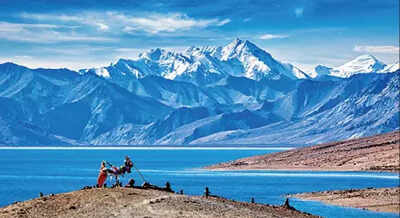Top Searches
- News
- India News
- Monitor glacier movement to save lives: Parliament panel to government
Monitor glacier movement to save lives: Parliament panel to government

(Credit: Getty Images/istock photo)
NEW DELHI: Noting the impact of climate change on glacier movement in the Indian Himalayan region, a parliamentary panel has asked the government to take suitable steps such as constant monitoring through setting up early warning systems and various adaptation measures to save lives and properties from disastrous consequences of global warming in future.
The panel, standing committee on water resources, suggested that the government must make concerted efforts to set up and widen the network of high altitude meteorological and discharge stations equipped with modern technology including ‘synthetic aperture radar (SAR) imagery to automatically detect changes in water bodies, including new lake formations, glaciers, glacial lakes and watersheds in the region.
The panel's report, tabled in the Parliament early this month, assumes significance in view of the recent report of the UN’s Intergovernmental Panel on Climate Change (IPCC) that projected how snow-covered areas and snow volumes will decrease in the Himalayan region during the 21st century due to rising global average temperature, leading to extreme weather events and disruption in the water cycle.
“Rising temperature and precipitation can increase the occurrence of glacial lake outburst floods (GLOFs) and landslides over moraine-dammed lakes,” said the IPCC in its report on August 9, predicting that the snowline elevations will rise and glacier mass is likely to decline, causing disastrous events in the region.
India had, in fact, witnessed such tragedy on February 7 when an avalanche in Chamoli district of Uttarakhand led to a flash flood, causing deaths of over 100 people and damage to an under-construction power plant.
In the backdrop of such risk in the Himalayan region, the parliamentary committee, headed by BJP Lok Sabha MP Sanjay Jaiswal, noted that the disasters such as flash floods, GLOFs and landslides are “expected to become more common in the future due to climate change”.
“In general, glaciers have been rapidly melting and retreating resulting in the formation of a number of moraine-dammed glacial lakes, posing numerous threats particularly to the population and infrastructure located nearby due to their outbursts,” said the panel while suggesting different agencies to work in collaboration on glacial management.
In India, glaciers in the Hindu Kush Himalaya region are a crucial water supply for 86 million people who live in the region. Glaciers such as in the Lahaul-Spiti region of western Himalaya have been losing mass since the start of the 21st century, and if greenhouse gas (GHG) emissions do not fall, glaciers in the Hindu Kush Himalaya would decline by two-thirds.
The IPCC report notes that human influence is very likely the main driver of the global retreat of glaciers since the 1990s and almost all of the world’s glaciers, including Himalayan ones, have retreated since the 1950s in an unprecedented manner. Mountain and polar glaciers will continue melting for decades or centuries.
The panel, standing committee on water resources, suggested that the government must make concerted efforts to set up and widen the network of high altitude meteorological and discharge stations equipped with modern technology including ‘synthetic aperture radar (SAR) imagery to automatically detect changes in water bodies, including new lake formations, glaciers, glacial lakes and watersheds in the region.
The panel's report, tabled in the Parliament early this month, assumes significance in view of the recent report of the UN’s Intergovernmental Panel on Climate Change (IPCC) that projected how snow-covered areas and snow volumes will decrease in the Himalayan region during the 21st century due to rising global average temperature, leading to extreme weather events and disruption in the water cycle.
“Rising temperature and precipitation can increase the occurrence of glacial lake outburst floods (GLOFs) and landslides over moraine-dammed lakes,” said the IPCC in its report on August 9, predicting that the snowline elevations will rise and glacier mass is likely to decline, causing disastrous events in the region.
India had, in fact, witnessed such tragedy on February 7 when an avalanche in Chamoli district of Uttarakhand led to a flash flood, causing deaths of over 100 people and damage to an under-construction power plant.
In the backdrop of such risk in the Himalayan region, the parliamentary committee, headed by BJP Lok Sabha MP Sanjay Jaiswal, noted that the disasters such as flash floods, GLOFs and landslides are “expected to become more common in the future due to climate change”.
“In general, glaciers have been rapidly melting and retreating resulting in the formation of a number of moraine-dammed glacial lakes, posing numerous threats particularly to the population and infrastructure located nearby due to their outbursts,” said the panel while suggesting different agencies to work in collaboration on glacial management.
In India, glaciers in the Hindu Kush Himalaya region are a crucial water supply for 86 million people who live in the region. Glaciers such as in the Lahaul-Spiti region of western Himalaya have been losing mass since the start of the 21st century, and if greenhouse gas (GHG) emissions do not fall, glaciers in the Hindu Kush Himalaya would decline by two-thirds.
The IPCC report notes that human influence is very likely the main driver of the global retreat of glaciers since the 1990s and almost all of the world’s glaciers, including Himalayan ones, have retreated since the 1950s in an unprecedented manner. Mountain and polar glaciers will continue melting for decades or centuries.
FacebookTwitterLinkedinEMail
Start a Conversation
end of article
Quick Links
Coronavirus in MumbaiFarm bill 2020Farmers protestCoronavirus in DelhiCoronavirus in BangaloreCoronavirus symptomsCoronavirus in IndiaWest Bengal elections 2021Coronavirus NewsSolar EclipseNPRWhat is NRCCAB BillCAB and NRCAssam election 2021Podcast newsLok SabhaTamil Nadu Election 2021CongressBJP newsKerala Elections 2021Indian ArmyISRO newsSupreme Court

